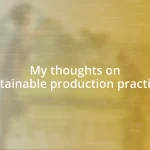Key takeaways:
- Failure should be viewed as a learning opportunity that fosters growth and improvement rather than a setback.
- Effective communication, quality control, and realistic timelines are crucial to preventing production failures.
- Creating a culture that embraces open feedback and thorough analysis of failures can drive innovation and enhance team collaboration.

Understanding the concept of failure
Failure, in any endeavor, can feel profoundly disheartening. I remember a time when a project I spearheaded flopped spectacularly; the disappointment was palpable. But in that moment, I realized failure isn’t just a pitfall—it’s a stepping stone toward growth and understanding. Have you ever felt that gut-wrenching fear when something doesn’t go as planned? It’s tough, but I’ve found that embracing these feelings often leads to important insights.
When we think of failure, we often associate it with shame or setback. But in my experience, that perspective can be limiting. After my failure, I took a long, hard look at what went wrong and discovered valuable lessons that shifted my approach entirely. It’s fascinating how each misstep can unveil hidden truths about our processes and assumptions. Have you considered how your own failures have shaped who you are today?
In the operational world, failure might seem daunting, yet it can provide clarity and direction. I once engaged in a production process that didn’t meet quality standards; it forced me to re-evaluate my team’s workflows. What initially felt like a frustrating roadblock ended up illuminating inefficiencies I’d overlooked for too long. Each failure, I’ve learned, is an invitation to dig deeper and ask why things didn’t work out, pushing me toward continuous improvement.

Common reasons for production failures
Production failures can often stem from a multitude of factors. One common reason I’ve encountered is poor communication within teams. I recall a project where my team misaligned on priority tasks because critical updates weren’t shared effectively. This lack of communication not only delayed our timeline but also caused frustration, ultimately leading to a product launch that didn’t meet expectations. This experience taught me that clear channels for updates and feedback are essential.
Another frequent cause is insufficient quality control measures. I remember when a batch of products failed quality checks due to overlooked specifications. It was disheartening to see the ripple effect of those errors. The experience highlighted the importance of robust testing and review processes. It’s a lesson I carry with me: without diligence in quality assurance, even the best ideas can falter.
Lastly, unrealistic timelines can crush a project’s success before it begins. In my early career, I was part of a startup that set aggressive deadlines. We rushed our production, leading to mistakes I can still vividly recall. The pressure created by those timelines was immense, and in the end, the product fell flat. This taught me that setting achievable deadlines allows for the creativity and thoroughness necessary for true success in production.
| Reason for Failure | Description |
|---|---|
| Poor Communication | Misalignment in team priorities due to ineffective updates. |
| Insufficient Quality Control | Failure to meet specifications leading to product errors. |
| Unrealistic Timelines | Rushed production resulting in compromised quality. |

Lessons learned from past failures
Reflecting on my past failures has been incredibly rewarding. Each setback whispers insights I might have ignored while celebrating successes. For instance, I recall a time when I proudly presented a new strategy only to see it falter due to inadequate testing. The sting of that failure was hard to shake. However, it pushed me to cultivate a more rigorous approach to validation before implementation. I learned that embracing a thorough review process can save time and prevent disappointment in the long run.
Here are some of the key lessons I’ve internalized from those experiences:
- Embrace Feedback: I used to fear criticism, but each piece of feedback helped me refine my strategies, turning vulnerabilities into strengths.
- Prioritize Communication: After experiencing the fallout from a silent team, I made it a rule to share updates frequently, fostering a culture of openness and collaboration.
- Value Preparation: The initial excitement of rolling out new ideas can cloud judgment; I’ve seen the power of meticulous planning and testing transform potential failures into triumphs.

Building resilience through adversity
When facing adversity, I realized that resilience is built through countless small failures, each carrying a lesson. I once worked on a project that fell apart not just due to poor planning, but also because we lost sight of our original vision amid setbacks. The frustration was palpable, but it taught me the importance of staying focused and adapting rather than giving in. I learned that every misstep can be a powerful teacher if we allow it to guide our future decisions.
I can’t help but think about how much growth comes from moments of difficulty. I remember when a critical software update went live, but it broke several key functionalities. It felt like a punch to the gut as the team scrambled to fix it. However, that experience forged an unbreakable bond among us, reinforcing the belief that together we could overcome anything. Embracing that adversity not only boosted our collective confidence but also deepened my understanding of collaboration in crisis.
It’s intriguing to consider how setbacks can drive innovation. After a significant failure in a product launch, I gathered my team for a brainstorming session, and to my surprise, the initial frustration morphed into creativity. We dissected what went wrong, transforming complaints into ideas for improvement. This shift in mindset, from seeing failure as a dead end to viewing it as a springboard for creativity, completely altered our approach to future projects. Doesn’t that make you wonder how many hidden opportunities lie within our failures?

Strategies for effective failure analysis
Understanding failure is as critical as any success. One strategy I’ve found invaluable is conducting a post-mortem analysis after each project, regardless of the outcome. I recall a launch that didn’t go as planned; once the initial shock faded, we sat down with the entire team to dissect the event. During that meeting, we uncovered not just technical flaws but also tension points in our communication. Reflecting together allowed us to identify actionable steps, turning a painful experience into a structured learning opportunity.
Additionally, I think establishing a culture that encourages risk-taking without fear of punishment can pave the way for genuine innovation. I’ve experienced environments where employees hesitated to share their missteps due to reputational concerns. But when I began to openly celebrate ‘failures’ as learning moments, it transformed our dynamics. I remember an instance where a colleague bravely shared a failed initiative. Instead of criticism, we applauded the courage, and I watched others open up, leading to breakthroughs we hadn’t anticipated. Isn’t it fascinating how the right atmosphere can encourage honesty and ultimately drive progress?
Finally, leveraging data for analysis is crucial. After one particularly challenging setback, we collected metrics to understand our users’ behavior. The numbers told a story that our initial assumptions had overlooked. By aligning quantitative insights with qualitative feedback, I realized we had been chasing the wrong goals. This dual approach not only helped us course-correct but also instilled a sense of accountability. When faced with failure, I often ask myself: what data tells us about our choices? This question has been a cornerstone of my reflection process, guiding me toward smarter decisions in the future.

Implementing changes for future success
Emphasizing proactive changes is vital for future success. I vividly remember a project where we didn’t take the time to gather user feedback before a major release. The aftermath was illuminating; not only did we miss the mark, but it also opened my eyes to how we could have better anticipated our users’ needs. Now, I make it a point to incorporate regular feedback loops into every phase of development. Have you ever thought about how listening to your audience can transform your approach?
In reflecting on my journey, I discovered that fostering a culture of open dialogue significantly impacts our adaptability. There was a time when team members feared voicing their concerns during critical project phases, resulting in avoidable mistakes. I took a step back and introduced structured check-in meetings, offering a platform for everyone to share insights and suggestions. It was remarkable to witness how this small change cultivated an environment where everyone felt valued, resulting in innovative solutions. Don’t you think that feeling heard can spark creativity?
Moreover, I learned that thorough documentation of past failures is essential. After a product issue nearly derailed my team’s workflow, I initiated a shared digital journal for lessons learned. This evolved into a robust reference that not only exposed our recurring pitfalls but also celebrated our victories. I often ask myself how much more effective we could be if we harnessed the collective wisdom of our experiences. Wouldn’t you agree that reflecting on the past can lay a strong foundation for the future?















